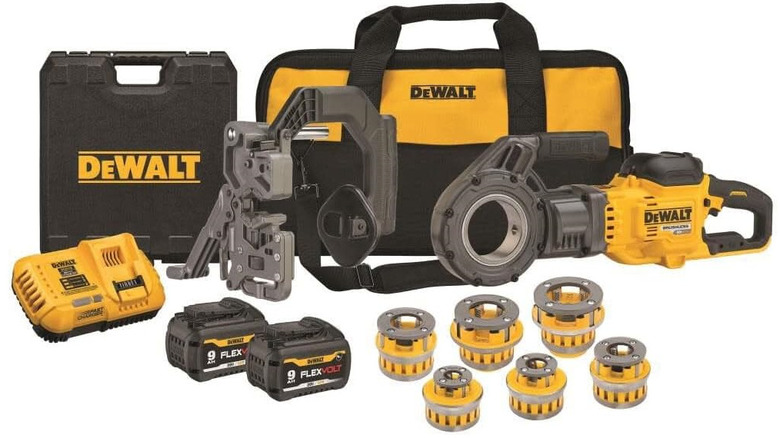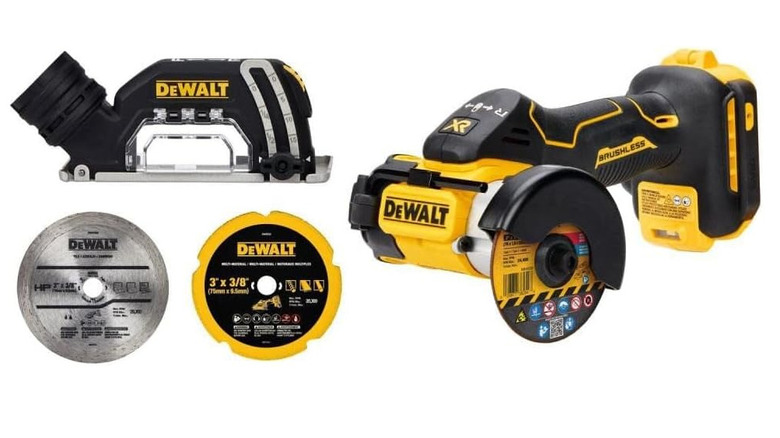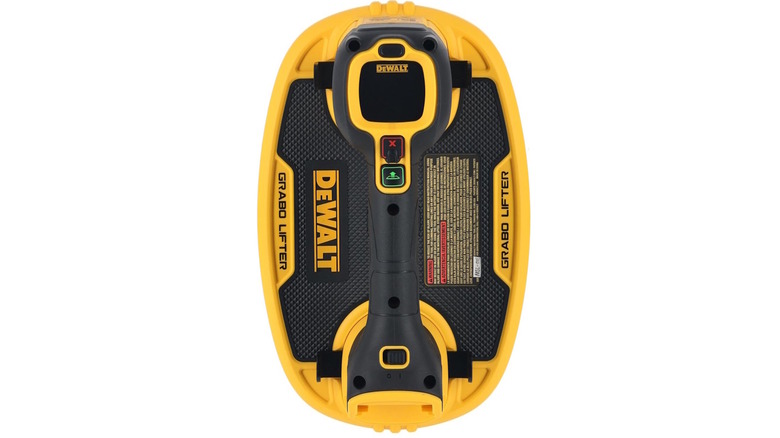5 Unique DeWalt Products (And What They're Used For)
We may receive a commission on purchases made from links.
You'd be surprised at the number of tools capable of completing extremely specific tasks, including ones you may never have even heard of before. There are multiple tools DeWalt has created for professionals to perform a distinct task, and we've rounded up some of the more unorthodox ones. The tools we've included on this list aren't likely ones you're going to run out and buy, but it may at least be interesting to learn about how they work. These are not the traditional DeWalt tools every homeowner should have in their garage.
All the items included on this list were reviewed as unique choices, as they likely won't be kept in a DIY toolbox or by someone who likes to work on projects around the house. These are likely carried by professionals, and the person using them has this tool for an exact purpose. We'll talk about what makes this tool unique and why someone would use it during a project.
DeWalt Benchtop Planer
The DeWalt Benchtop Planer is a peculiar tool designed for a clear-cut task: refine and shave down wood and other materials. Although this tool seems large and cumbersome, it is designed to be portable, and you can bring it with you onto job sites to help plane any of the lumber you're using. The traditional, industrial version of this tool is significantly larger and handles much bigger pieces of lumber on a massive scale. This is bigger than the electric hand planer that every woodworking workshop needs.
When operating the machine, you'll dial in and adjust the settings to input the dimensions you want for your lumber. After the dimensions are set, the piece of wood you want to use goes into the machine and slides through the various knives and blades inside. These blades gradually shave off and tone down the lumber, refining it into the preferred shape you want to use. You should have a cleaner piece of lumber when it comes out on the other end.
You'd like to use this machine when you need to use a piece of lumber with precise dimensions. Because the dimensions are already in the machine, you can load more wood into it, so multiple pieces look the same.
DeWalt Pipe Threader
For those who don't deal with plumbing, the DeWalt Pipe Threader might look like a strange tool. This is a must have tool that you'll use when completing at-home plumbing projects, though it won't have too much use outside of construction sites where the designing of metal pipes for the interiors of buildings mostly happens.
Generally, a pipe threader applies adds the specific threads needed to ensure the liquid held within a pipe doesn't leak through at its connections. How you use the DeWalt Pipe Threader is by placing the pipe through the clamp and settling the end into the tool. From here, the threads move around the pipe and slowly carve away into the metal, creating distinct threading. Once it's finished, the tool is pulled away, and the pipe has a brand new set of threads. These can be male or female, depending on what type you're making with this tool.
Alternatively, you might use this tool on a drainage line if there's a leak in the pipes. There's a good amount of versatility with this tool, but only if you're laying down metal piping yourself for a project.
DeWalt 3-Inch Cut-Off Tool
The DeWalt 3-Inch Cut-Off Tool is distinct because of how precise it is with its measurements. This hand power tool only goes 3 inches deep, but it offers a distinct way for you to slice straight through hearty materials like cement, tile, stone, or board, and not too many people require that type of precision from a saw. The shallowness of blade means you won't be cutting through heaps of those materials, but its construction makes it incredibly sharp and robust.
The 3-inch cut-off tool features a rotary diamond saw blade that you'll use to cut through tough materials, and it works similarly to other hand saws that you may have used on other projects. The main difference is what materials you're using with this blade, and how precise you need to be during a project. You can also connect it to an extractor if you want to make sure none of the debris gets out when you're cutting.
If you're laying down piping, tile, or stones, bringing this out is a good way to refine these materials before you lay any of them down for a heavy-duty project. It's why we recommend this tool if you're looking for a cut-off saw, although it does have limitations.
DeWalt 20V Max Grabo Lifter
To make sure you never drop something precious or delicate when working on a construction job, consider the DeWalt 20V Max Grabo Lifter. It looks like a small handle that you'd use to scale a wall when robbing a bank, but this power tool is actually a device that holds on tight to a specific material. So long as you don't drop the grabo lifter, the item won't fall and hit the ground.
The grabo lifter is a grip with a vacuum suction cup on the front, and utilizes a battery to keep an item it's holding in place. You use it by placing the suction cup against an object, flipping the switch on the grip, and it should suck up the object and cling to it, not letting go until you hit the button again. The type of objects you'd use this on includes glass, stone, drywall, or even tiles, if they're large enough. The objects you'd use a grabo lifter on are several hundred pounds, meaning you're using this tool for precision and stability. We've covered the DeWalt Max Grabo Lifter before, explaining how it works in more detail.
DeWalt Grease Gun
Another tool you might not have seen or used before, if you don't traditionally use large equipment, is the DeWalt Grease Gun. You may have spotted ones in car shops, but this one is much larger, with a motor that can produce 10,000 PSI. You might consider greasing your car's shocks and struts if you have a grease gun. It's a specialized tool that applies lubrication to a massive mechanism where there's a chance for friction to occur between non-sealed components that have a chance to wear down over time. The reason you'd use this tool is to increase the quality of a mechanism's components.
To use the DeWalt grease gun, first remove the cylinder from the tool, and add the grease into the barrel. The grease you load into the tool typically comes in cylinders, so you shouldn't worry about getting it everywhere. When you've done that, put the barrel back into the tool, and you're ready to use it. The grease gun has a hose that you aim to apply the grease, allowing you to place it into a mechanism's grease fittings.
A grease fitting, also called a zerk fitting, is a one-way check valve that releases grease at precise points throughout an equipment piece. You find them on bearing housings or components that deliver the grease from the grease gun to specific locations within a moving part to keep them healthy.





